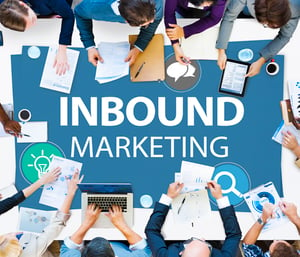Is An Inbound Marketing Agency Right For My Business?
Growth is a natural goal for any business, but not all roads lead to winning strategies for accomplishing this.
7 min read
 Bill Walls
:
May 28, 2021 5:05:30 PM
Bill Walls
:
May 28, 2021 5:05:30 PM

Getting a prospect’s attention has never been more difficult in today’s digital age.
One of the terms you may have heard about is inbound marketing. Many companies have started going to this effective marketing method and are seeing great results.
So, what is the inbound marketing definition, how does it compare to your current marketing efforts and how do you know it’s right for your business?
 What Is Inbound Marketing?
What Is Inbound Marketing?
Inbound marketing attracts customers by creating valuable content that is tailored to them. Successful inbound marketing creates connections, solves problems and allows customers to come to you.
In other words, rather than pushing your message in front of people who might not be interested, inbound marketing allows you to establish yourself as an authority in your industry using the internet. When customers search the internet for your product or service, they will naturally discover your brand.
Here’s what allows inbound marketing to work: Your prospects receive your message on their terms, making them far more receptive to what you have to say. But in order for inbound methodology to be successful, you must have a good understanding of what customers need throughout their buyer’s journey. This allows you to build trust, as well as provide the content and messaging needed to assure them and guide them toward making a purchase from you.
An important part of ensuring you have a winning inbound marketing plan is identifying your buyer personas.
What is a buyer persona? Buyer personas are fictional representations of your ideal customers, based on real data about customer demographics and online behavior. And, typically, companies will have more than one. When determining buyer personas, other information taken into account includes speculation about their personal histories, motivations and concerns.
In other words, buyer personas are your target audience. However, your buyer personas should not be a vague description of the type of people you’re trying to gear your marketing efforts toward. Instead, your buyer personas should be defined according to well-researched demographic information.
So how do you find your buyer personas? You’ll need to ask yourself some key questions, such as:
Answering these questions will help you develop your buyer personas. Buyer personas are critical in inbound marketing because you must understand who your target audience is in great detail in order to help your marketing and sales team create useful and relevant content that is valuable to them.
You can read more about this process in our article, Keys To Finding Your Ideal Buyer Persona.
Once you figure out your buyer persona, you’re set for inbound marketing, right? Not exactly. There are five fundamentals of inbound marketing, one of which is the buyer persona. But if you miss any of the others in your inbound marketing strategy, it can stifle your return on investment (ROI). And then you may feel as though inbound marketing doesn’t work.
Understanding these fundamentals, however, will help you develop a marketing plan that focuses on doing business that is more human- and customer-centered.
 The five fundamentals are:
The five fundamentals are:
1. Contacts: These can be from a variety of sources, from people who you’ve engaged with and have become leads, to industry experts, other businesses and individuals who have interacted with you on social media. Investing in Customer Relationship Management (CRM) software can help your sales team keep detailed records on these contacts and track them in the sales pipeline.
2. Buyer personas: As we discussed above, buyer personas are fictionalized representations of your ideal customers. Acquiring data through your website, CRM, social media, Google Ads, SEO and other analytic tools can also help you determine who these people are and what they have in common.
3. Buyer’s journey: The buyer’s journey looks at how a contact goes from being a stranger to a paying customer. It’s based on data and will help you create content that reaches the buyer persona. There are three stages to a buyer’s journey:
5. Goals: Lastly, a marketing strategy should include measurable goals that help you determine what’s working and what isn’t working. Setting goals and keeping track of your progress are essential.
Inbound marketing includes four key phases:
1. Attract
2. Convert
3. Close
4. Delight
In the attract phase, we are looking to attract the right traffic to the company website. These are the individuals who are most likely to become leads and the most qualified prospects for your company’s products and services. This is where your buyer persona plays a role.
In the convert phase, the next step is to develop them into qualified leads by gathering their contact information. Typically at the early stages of this phase, you’ll only need their email address. As they move down your sales funnel, more information may be requested. The content you develop provides the needed value for a potential customer to offer up their contact information.
In the close phase, you transform your contents into customers. Closing tools to help you with this process include CRM software, email and marketing automation.
Your work is not done, however. In the delight phase, you continue to supply qualified prospects and satisfied customers with valuable content. Tools used in this stage include surveys, calls-to-action, smart text and social monitoring.
You can read more about each of these phases in our article, What Is Inbound Marketing?
 If you’re like many businesses, you likely have used or are using outbound marketing. Outbound marketing describes the traditional advertisements that were very popular decades ago and are still used today. These include television ads, radio ads, flyers received in the mail and billboards.
If you’re like many businesses, you likely have used or are using outbound marketing. Outbound marketing describes the traditional advertisements that were very popular decades ago and are still used today. These include television ads, radio ads, flyers received in the mail and billboards.
While you may feel like you are being proactive with this sales strategy, and you may grab a few customers based on playing the numbers game, there are a few problems with this type of marketing. First, outbound sales can be limited and costly. Outbound marketing is also described as interruptive and even pushy, hyper-commercialized and impersonal.
Outbound marketing also involves cold calling, which is often dreaded among sales staff and the prospects on the other end of the phone.
Inbound and outbound marketing are very different. One of the biggest differences involves the type of content you produce to attract and convert quality leads.
For example, when incorporating inbound marketing into your sales strategy, you may use the following types of content:
The top priority for marketers is lead generation, according to Hubspot. Inbound marketing is the most cost-effective way to nurture leads that can be closed through the inbound sales process.
If you are asking whether inbound marketing is right for you, you’re not alone. With many marketing strategies out there, it can be difficult to know whether this type of sales strategy is the right one for your business.
After all, change is difficult and always begins with a lot of thought and a little introspection. Here are some questions to ask yourself:
 Do your products or services require a level of education before a purchase is made?
Do your products or services require a level of education before a purchase is made?If you answered “yes” to most of these questions, inbound marketing is a good fit for your business. If you answered “no” to some of the questions, this doesn’t mean inbound marketing isn’t a good fit for your business and you may need to look a little more deeply at your answers to determine whether the data backs up your answers. If you answered “no” to all of these questions, inbound marketing may not be right for you.
Keep in mind that it’s always a good idea to periodically review your prospects’ buyer behavior. Circumstances change, and so might your need for inbound marketing.
If you’re feeling a bit overwhelmed, agencies that specialize in inbound marketing can help by moving your sales strategy toward inbound marketing while allowing you to focus on the day-to-day operations of your business.
Here are five reasons why hiring an inbound marketing agency may make sense for your company:
1. Time: Drafting the many different creative elements that go into a winning strategy can take a lot of time. Between copywriting, graphic design, computer programming and search engine optimization (SEO), it can be difficult to master all of these creative disciplines, let alone get past the learning curve when you have enough on your hands running a business.
2. Resources: Inbound marketing agencies have all the tools required to develop a winning inbound strategy. This includes programs for SEO, creative suites for design, programs to manage contacts, social media schedulers and many other subscriptions to handle your inbound needs.
3. People: Inbound marketing agencies are equipped to meet the staffing needs associated with all these different roles. With degrees, certifications and hands on experience, agency employees each have a specialized knowledge that can help your business’ mission. Among these experts are writers, graphic artists, SEO specialists, programmers and marketing strategists. It’s important to note that consistency in your content is crucial to building an audience.
4. Experience: Agency professionals have worked with companies just like yours and know what works and what doesn’t, saving your company precious resources. While a marketing strategy requires trial and error, one of the biggest advantages to working with an inbound agency is that it has made the mistakes and learned from them, saving your company time and money in the long term.
5. Money: Hiring one marketing manager to oversee the marketing process can be significantly more expensive than outsourcing your marketing needs to an agency. No one person is going to possess all the skills you need to execute an inbound strategy either. The costs in terms of time and money can add up if you try to execute an inbound strategy in-house.
Hiring a qualified agency, on the other hand, can jump start your marketing program, create a steady stream of qualified prospects for your sales team, and save you time and costs. In return, you will receive experience, resources and specialized knowledge that will help you build your business.

Growth is a natural goal for any business, but not all roads lead to winning strategies for accomplishing this.

Hiring a digital marketing agency can put you on the right path toward growing your business. The wrong agency can bring your journey to a halt,...

With a new year just around the corner, you may be among the small business owners who are taking this time to dive into your numbers.